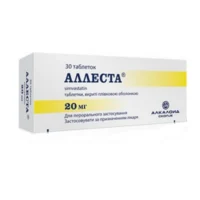Description
Envarsus (Tacrolimus) Tablets with Prolonged Release 1 mg. №60
Ingredients
Active ingredient: Tacrolimus
Other ingredients: lactose monohydrate, hypromellose, croscarmellose sodium, magnesium stearate, and more.
Mechanism of Action
Tacrolimus is a calcineurin inhibitor that suppresses the immune system by inhibiting T-lymphocyte activation. This action helps prevent organ rejection in transplant patients.
Pharmacological Properties
Tacrolimus exerts its immunosuppressive effects by targeting T-lymphocytes, thereby reducing the risk of rejection in organ transplant recipients.
Indications for Use
Indicated for: Envarsus tablets are indicated for the prevention of organ rejection in adult kidney or liver transplant patients.
Contraindications
Contraindications: Envarsus tablets are contraindicated in individuals with hypersensitivity to tacrolimus or any component of the formulation.
Side Effects
Common side effects of Envarsus tablets may include gastrointestinal disturbances, tremors, hypertension, and renal dysfunction. Patients should report any unusual symptoms to their healthcare provider.
Usage Instructions
Dosage: The usual starting dose of Envarsus tablets is 0.1 to 0.15 mg/kg once daily. Dosage adjustments may be necessary based on blood levels and clinical condition.
Directions: Take Envarsus tablets exactly as prescribed by your healthcare provider. Swallow the tablet whole with a glass of water.
Benefits Compared to Analogues
Envarsus tablets with prolonged release offer the advantage of once-daily dosing, providing effective immunosuppression and potentially improving patient adherence and outcomes compared to immediate-release formulations.
Suitable Patient Groups
Envarsus tablets may be suitable for adult kidney or liver transplant patients who require long-term immunosuppressive therapy. Dosage adjustments may be necessary for elderly patients or those with renal impairment.
Storage and Shelf Life
Store Envarsus tablets in a cool, dry place away from direct sunlight. Check the expiration date on the packaging and do not use the tablets if expired.
Packaging Description
Each package of Envarsus tablets contains 60 tablets of 1 mg strength. The packaging is designed to maintain the integrity and stability of the tablets.
Scientific Evidence
Pharmacological Effects: Tacrolimus is a calcineurin inhibitor that suppresses the immune system by inhibiting T-lymphocyte activation. This action helps prevent organ rejection in transplant patients.
Clinical Trials: Clinical trials have shown that Envarsus tablets with prolonged release provide effective immunosuppression with once-daily dosing, leading to improved patient adherence and outcomes compared to immediate-release formulations.
Additional Information
It is crucial to monitor tacrolimus blood levels regularly to ensure therapeutic efficacy and prevent toxicity. Patients should avoid grapefruit and grapefruit juice while taking Envarsus tablets as they can increase tacrolimus levels in the blood.
Prior to starting Envarsus, patients should discuss with their healthcare provider any other medications, supplements, or herbal products they are taking to prevent potential drug interactions.





